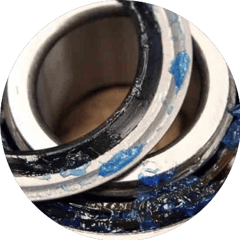

Silicone greases (also known as dielectric greases) are synthetically-derived pseudoplastic lubricants. Formulated from silicone oils of the same name, they are characterised by superior adhesiveness and permanence at friction points due to the use of thickening agents that are:
The family of silicone lubricating greases contains numerous variations both in terms of the composition of the base oil and the nature of the thickener. The thickener is responsible for the thixotropic conduct and thus the adhesive and cohesive properties for the lubrication zones, along with the lubricating power.
The strengths of silicone greases are closely linked to the type of base oil used in their formulation and can be distinguished as:

Silicone greases are part of the family of synthetic lubricants and thus enjoy many strengths that make them the preferred choice where mixed friction combinations between polymeric materials and metals under prolonged and extended thermal stresses are envisaged.
Amongst the main characteristics we can distinguish:
HEAD OFFICE:
Macon Research Srl
Via Santa Lucia, 8/D
36056 Tezze sul Brenta (VI)
Tel.+39 0424.57.39.66
Fax.+39 0424.57.39.66
Mail: info@maconresearch.com
ADMINISTRATIVE OFFICE:
Macon Research Srl
Via L. Tolstoj, 43/O
20098 San Giuliano Milanese (MI)
Tel.+39 02.98.24.41.61
Fax.+39 02.98.24.4161
Mail : info@maconresearch.com
The data contained in this catalogue are based on our general experience and knowledge at the time of publication and are intended to provide the reader with technical information about any possible uses. This information does not, however, constitute an assurance as regards product characteristics in relation to specific cases. We recommend that you request an interview with our consultants. We would be happy to provide you with samples.